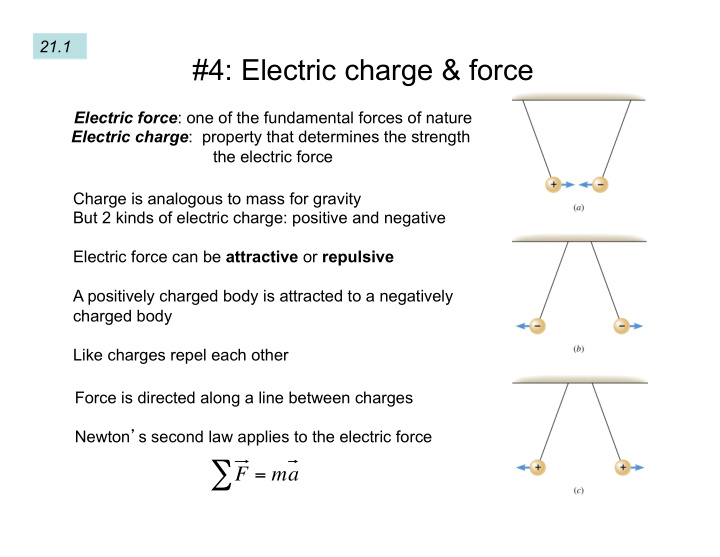



21.1 #4: Electric charge & force Electric force : one of the fundamental forces of nature Electric charge : property that determines the strength the electric force Charge is analogous to mass for gravity But 2 kinds of electric charge: positive and negative Electric force can be attractive or repulsive A positively charged body is attracted to a negatively charged body Like charges repel each other Force is directed along a line between charges Newton ’ s second law applies to the electric force ∑ F = ma
Electricity and atoms results from the properties of the electric force The structure of atoms determines how the electric force impacts our world Not to scale Very small nucleus Protons (positive charge) Neutrons (no charge) Massive (~99.98%) 10 -13 cm Orbiting electrons Negative charged “ Large ” radii -Charge on an electron exactly equals that of a proton (1.602x10 -19 Coulombs) Total electric charge is conserved and quantized Quantized = no fractional electrons or protons Conserved = in a closed system particles are not created or destroyed
Historical context The classical theory of Electricity and Magnetism was developed largely in the late 1700 ’ s - early 1800 ’ s James Clerk Maxwell 1861-1865 The electron was not discovered until 1897 J. J. Thomson
Benjamin Franklin 1752 kite flight? Currier & Ives Other job: Revolutionary (1706-1790) Also famous for: Born: Boston, MA Bifocal glasses Father: Josiah Franklin (tallow) Mother: Abigail Folger Law: Conservation of electric charge (1860) Favorite invention: Lightning rod He said it: “ A penny saved, is a penny earned. ” “ Why He Was A Babe Magnet ” - Time (2003)
Movement of electric charge Electric charge (electrons) can move through objects Analogous to transfer of heat (thermal conductivity) How well electrons move through a material is determined by how the molecular structure of the material: the freedom of the outer (valence) electrons Conductors - electrons flow relatively freely through material most metals: aluminum, copper, gold Insulators - electrons do not flow (much) plastics, glass, ceramics Semiconductors - wide range of properties → Integrated circuits
Charging by contact On a charged (metallic) object, the electric charge distributes itself evenly on the surface Like charges repel Two charged objects brought into contact → total charge is the same → charge will redistribute itself Objects then separated → total charge is the same → charge on each object likely different A metal sphere (A) with a charge of 8 C and an identical sphere (B) with a charge of -4 C are brought into contact, then separated. What is the final charge on sphere A?
Charging by induction Charged objects to not have to touch to have an effect Presence of nearby charges causes charges in metal sphere to redistribute If metal sphere is connected to “ ground ” then some positive charges will “ flow ” to ground, leaving sphere with a net positive charge. Situation with insulators is a little more complex. Charge does not readily flow through the entire object. Can induce rearrangement near surface, which results in an attractive force → the origin of static cling
World’s largest van de Graaff At Oak Ridge National Laboratory (Oak Ridge, TN)
Concept Question You are given three identical metal spheres. One (Sphere A) initially has a charge of +8 µ C. The other two (Sphere B and Sphere C) initially have no charge. You touch Sphere A to Sphere B then separate them. You then touch Sphere B to Sphere C, then separate them. Finally, you touch Sphere A to Sphere B, and then separate them. What is the final charge on Sphere A? A. 0 (no charge) B. + 2 µ C C. + 3 µ C D. + 4 µ C
Concept question Two identical metal spheres are in contact with each other as shown. A negatively charged rod is brought near the spheres, but does not touch them. The spheres are separated, and the rod is removed. Which of the following statements regarding the mass of the spheres is true? A. m A > m B B. m A = m B C. m A < m B
Identical balls with mass m and electric charge q are suspended from strings as shown below. What is the electric force acting on each ball? = F g + F e + F t = 0 ∑ F y F gx + F ex + F tx = 0 60 ° x F t F ex = − F tx F ty 60 ° F gy + F ey + F ty = 0 q q F tx F ty = − F gy = mg F e F g F gy = − mg tan(60 ) = F ty 3 = F tx F ex = − mg F tx = F ty = mg 3 3 3
Recommend
More recommend